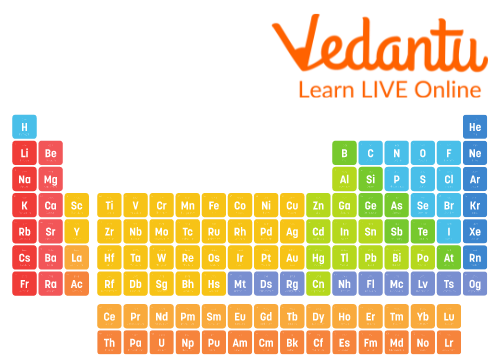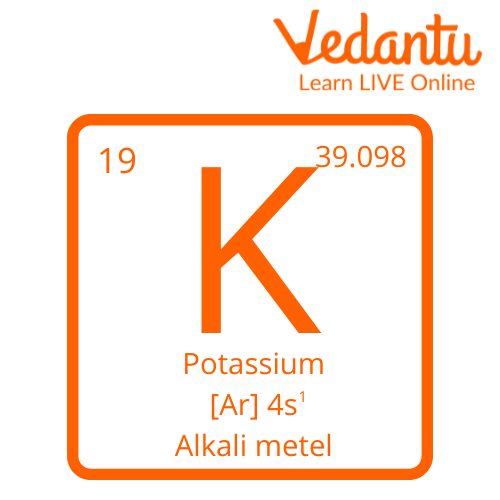




Understanding the Element of Potassium
The periodic table of chemistry is one of the most important for the perfect working of different reactions. This table contains elements found throughout the earth that significantly come into use in our lives for different processes. There are about 118 elements in the periodic table among which some are metals while some are non-metals and have different properties to them which makes them unique from each other. The table is made with several pieces of information which are depicted in the elements like their atomic number, atomic weight, electronic configurations, etc.

Periodic Table
One such element whose information can be grasped through the periodic table is potassium. Let us discover more information about the different features and properties of potassium.
Information about Potassium under Periodic Table
Potassium is considered an alkali metal which has a placement as the fourth element on the first column of the periodic table. The element potassium contains 19 electrons, and 19 protons and potassium valence electrons are just one which is placed on the outer shell of the periodic table.
Some of the Major Information on Potassium includes the following-
Atomic Number: 19
Atomic Weight: 39.0983
Classification: Alkali Metals
State: Solid at room temperature
Another element that is considered a similar element to Potassium is the element Sodium which is placed right above potassium in the periodic table. The element potassium was discovered in 1807 by Humphry Davy who was an English chemist.
Properties of Potassium
There are several different properties of potassium which makes it a unique element of the periodic table. It is considered to have a very low melting point and even excess atmospheric heat can cause the potassium to melt.
Potassium has a purple flame when it catches fire and is considered the second lowest density element after lithium, and has the property to float on water. Some of its other physical properties make it able to be cut through a knife and is a silvery metal with a very soft surface.
Some of the chemical properties of potassium include its high reactivity. Potassium is capable of producing heat along with hydrogen if in contact with water. It is also capable of reacting with different mediums like different acids, nitrogen, oxygen, etc.
Why is the Potassium Symbol k?
The elements of the periodic table have been assigned with different symbols, all of these symbols are unique to every element and generally contain a letter that is present in the name of those metals.
Although there are several exceptions like potassium who have a different letter as its symbol which is not even present in its name. This exception for potassium is present due to the Latin origin of the word.

Symbol of Potassium
Potassium has the K symbol as its denotation in the periodic table which mainly denotes the Latin word ‘kalium’ which means potash in English. Since potash salt was the object through which potassium was imparted, hence it has contributed to its name.
Uses and Sources of Potassium
The element potassium due to its high reactivity is not found significantly alone in any natural form. It is found in different minerals in a compound form such as sylvite, kainite, etc. All the minerals which contain potassium are known as potash.
Potassium is considered to be one of the most abundant elements on the earth’s crust and ranks 8th among the top ten abundant elements of the earth. Potassium consists of 2.1% of the Earth’s crust.
Since potassium is considered an abundant element, it also has several usages. Potassium is considered a very necessary element for our body since it balances muscle contraction, pH, and bone health.
Some other uses of potassium are present in the making of fertilisers which help in plant growth and also have industrial usage for making substances like soap, detergents, dyes, etc.
Summary
Potassium is considered one of the most important elements for both earth and the human body as well. Loss of potassium from our earth or body can pose several issues and threats. It has different usages important for the easy function of our everyday life but should be handled with care since it is a very reactive element. Potassium has many different uses in our daily lives and also in industrial activities. The uses of potassium are listed as follows-
It is used as a replacement for sodium in the batteries of cars.
It is also used in potash which helps with plant growth and fertiliser.
FAQs on Uses for Potassium and Its Properties
1. What are the Isotopes of Potassium?
In easy words, isotopes can be described as the species of different elements which have almost the same chemical and physical behaviour with the same atomic number but contain a different atomic mass or mass number. Almost every element on the earth has an isotope and hence potassium does too. There are many isotopes of potassium but there are three of them which exist on the earth naturally. These isotopes are mainly K-39, K-40, and K-41. The most abundant isotope of Potassium is considered K-39 which has an availability of 93% in nature.
2. What is the Electronic configuration of Potassium?
Every element present on the Earth has electrons present on different orbitals of the atoms. These electrons have different significance and allow different reactions to be made in chemistry. In easy words, the electronic configuration can be defined as the distribution of electrons through the different atomic orbitals of an element. Potassium too has an electronic configuration that determines how many valence electrons that element has. The electronic configuration of potassium is 1s2 2s2 2p6 3s1.
3. What is the importance of potassium in the human body?
Potassium is an important element for several reasons. It is one of the most important elements to maintaining body mass, avoiding cardiac arrest, and muscle movement which are very vital to the human body. Potassium plays a very crucial role in maintaining the body mass too by aiding muscle contraction and also balancing the pH levels in our body. The reason why potassium has many usages in the human body is due to its ability to help maintain almost all tissues of our bodies.









